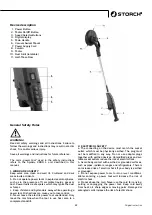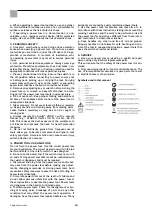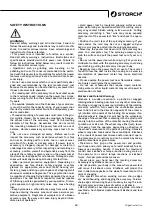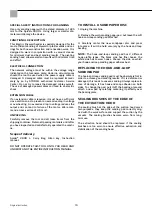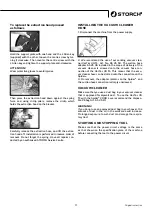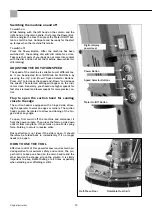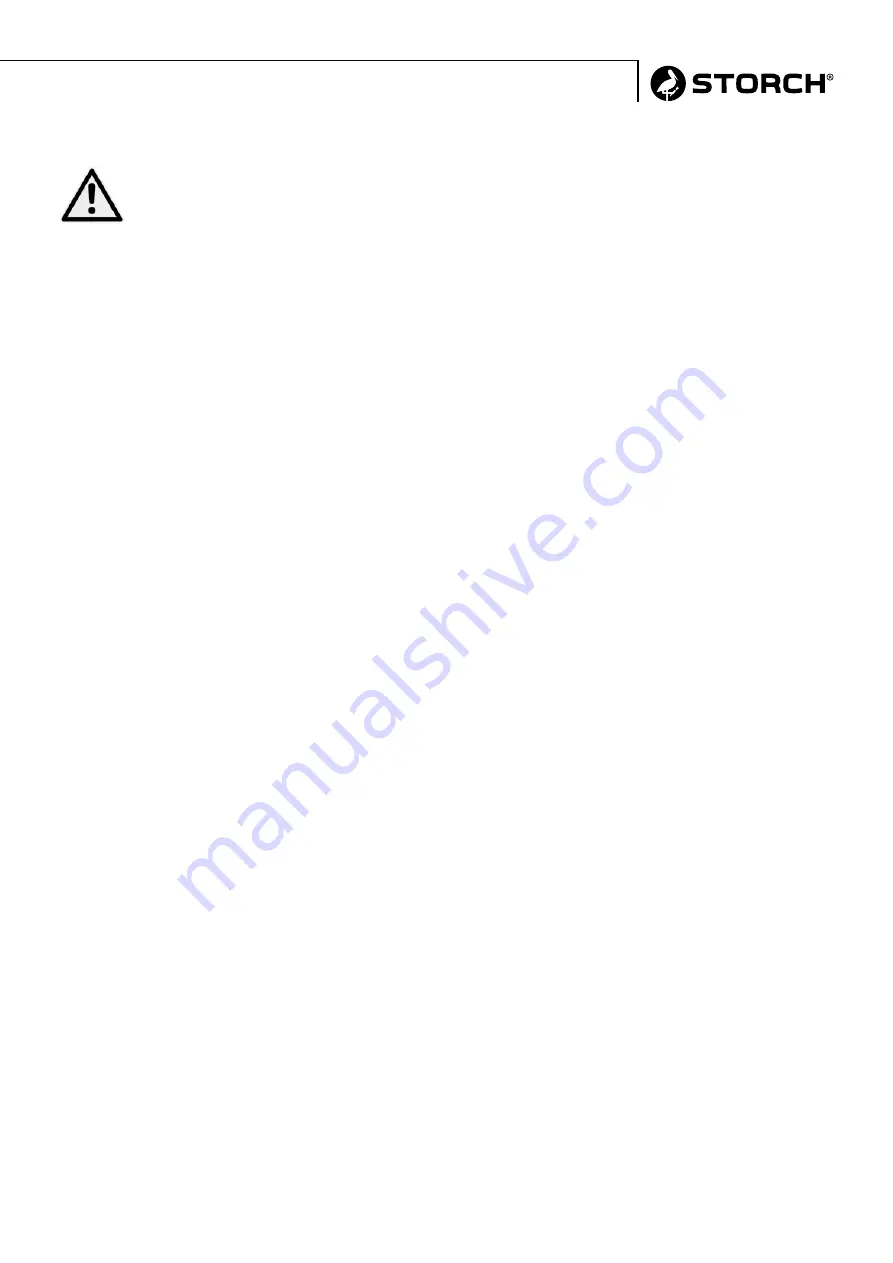
69
Original instruction
SAFETY INSTRUCTIONS
WARNING!
Read all safety warnings and all instructions. Failure to
follow the warnings and instructions may result in electric
shock, fire and/or serious injuries. Save all warnings and
instructions for future reference.
• This power tool is intended to function as a sander.
Read all safety warnings, instructions, illustrations and
specifications provided with this power tool. Failure to
follow all instructions listed below may result in electric
shock, fire and/or serious injury.
• Operations such as grinding, wire brushing, or for
polishing and cut-off are not recommended to be perfor-
med with this power tool. Operations for which the power
tool was not designed may create a hazard and cause per-
sonal injury.
• Do not use accessories which are not specifically desi-
gned and recommended by the tool manufacturer. Just
because the accessory can be attached to your power tool,
it does not assure safe operation.
• The rated speed of the accessory must be at least equal
to the maximum speed marked on the power tool. Acces-
sories running faster than their rated speed can break and
fly apart.
• The outside diameter and the thickness of your accesso-
ry must be within the capacity rating of your power tool.
Incorrectly sized accessories cannot be adequately guar-
ded or controlled.
• Threaded mounting of accessories must match the grin-
der spindle thread. For accessories mounted by flanges,
the arbour hole of the accessory must fit the locating
diameter of the flange. Accessories that do not match
the mounting hardware of the power tool will run out of
balance, vibrate excessively and may cause loss of con-
trol.
• Do not use a damaged accessory. Before each use
inspect the accessory such as abrasive wheels for chips
and cracks, backing pad for cracks, tear or excess wear,
wire brush for loose or cracked wires. If power tool or
accessory is dropped, inspect for damage or install an
undamaged accessory. After inspecting and installing an
accessory, position yourself and bystanders away from the
plane of the rotating accessory and run the power tool at
maximum no-load speed for one minute. Damaged acces-
sories will normally break apart during this test time.
• Wear personal protective equipment. Depending on
application, use face shield, safety goggles or safety
glasses. As appropriate, wear dust mask, hearing pro-
tectors, gloves and shop apron capable of stopping small
abrasive or workpiece fragments. The eye protection must
be capable of stopping flying debris generated by various
operations. The dust mask or respirator must be capable
of filtrating particles generated by your operation. Prolon-
ged exposure to high intensity noise may cause hearing
loss.
• Keep bystanders a safe distance away from work area.
Anyone entering the work area must wear personal pro-
tective equipment. Fragments of workpiece or of a broken
accessory may fly away and cause injury beyond imme-
diate area of operation.
• Hold power tool by insulated gripping surfaces only,
when performing an operation where the cutting acces-
sory may contact hidden wiring or its own cord. Cutting
accessory contacting a “live” wire may make exposed
metal parts of the power tool “live” and shock the opera-
tor.
• Position the cord clear of the spinning accessory. If you
lose control, the cord may be cut or snagged and your
hand or arm may be pulled into the spinning accessory.
• Never lay the power tool down until the accessory has
come to a complete stop. The spinning accessory may
grab the surface and pull the power tool out of your con-
trol.
• Do not run the power tool while carrying it at your side.
Accidental contact with the spinning accessory could snag
your clothing, pulling the accessory into your body.
• Regularly clean the power tool‘s air vents. The motor‘s
fan will draw the dust inside the housing and excessive
accumulation of powdered metal may cause electrical
hazards.
• Do not operate the power tool near flammable materi-
als. Sparks could ignite these materials.
• Do not use accessories that require liquid coolants.
Using water or other liquid coolants may result reesult in
electrocution or shock.
Kickback and Related Warnings
Kickback is a sudden reaction to a pinched or snagged
rotating wheel, backing pad, brush or any other accessory.
Pinching or snagging causes rapid stalling of the rotating
accessory which in turn causes the uncontrolled power
tool to be forced in the direction opposite of the accesso-
ry’s rotation at the point of the binding. For example, if an
abrasive wheel is snagged or pinched by the workpiece,
the edge of the wheel that is entering into the pinch point
can dig into the surface of the material causing the wheel
to climb out or kick out. The wheel may either jump towa-
rd or away from the operator, depending on direction of
the wheel’s movement at the point of pinching. Abrasive
wheels may also break under these conditions. Kickback
is the result of power tool misuse and/or incorrect opera-
ting procedures or conditions and can be avoided by taking
proper precautions as given below.
• Maintain a firm grip on the power tool and position
your body and arm to allow you to resist kickback forces.
Always use auxiliary handle, if provided, for maximum
control over kickback or torque reaction during start-up.
The operator can control torque reactions or kickback
forces, if proper precautions are taken.
• Never place your hand near the rotating accessory.
Accessory may kickback over your hand.
• Do not position your body in the area where power tool
will move if kickback occurs. Kickback will propel the
tool in direction opposite to the wheel‘s movement at the
point of snagging.
• Use special care when working corners, sharp edges
etc. Avoid bouncing and snagging the accessory. Corners,
sharp edges or bouncing have a tendency to snag the rota-
ting accessory and cause loss of control or kickback.
• Do not attach a saw chain woodcarving blade or toothed
saw blade. Such blades create frequent kickback and loss
of control.
Summary of Contents for Spider 2800 L
Page 11: ...11 Übersetzung der Originalanleitung Detailzeichnung ...
Page 13: ...13 Übersetzung der Originalanleitung Set 1 Set 2 Set 3 Set 4 Set 5 Set 6 ...
Page 27: ...27 Vertaling van de originele handleiding Detailtekening ...
Page 29: ...29 Vertaling van de originele handleiding Set 1 Set 2 Set 3 Set 4 Set 5 Set 6 ...
Page 43: ...43 Traduction des instructions d origine Dessin détaillé ...
Page 45: ...45 Traduction des instructions d origine Kit 1 Kit 2 Kit 3 Kit 4 Kit 5 Kit 6 ...
Page 59: ...59 Traduzione delle istruzioni originali Disegno dettagli ...
Page 61: ...61 Traduzione delle istruzioni originali Set 1 Set 2 Set 3 Set 4 Set 5 Set 6 ...
Page 75: ...75 Original instruction Detailed drawing ...
Page 77: ...77 Original instruction Set 1 Set 2 Set 3 Set 4 Set 5 Set 6 ...
Page 79: ...79 Original instruction Wiring Set 8 Set 9 Set 10 Set 11 ...
Page 91: ...91 Překlad originálu návodu Podrobný výkres ...
Page 93: ...93 Překlad originálu návodu Sada 1 Sada 2 Sada 3 Sada 4 Sada 5 Sada 6 ...
Page 98: ...98 ...
Page 99: ...99 ...













